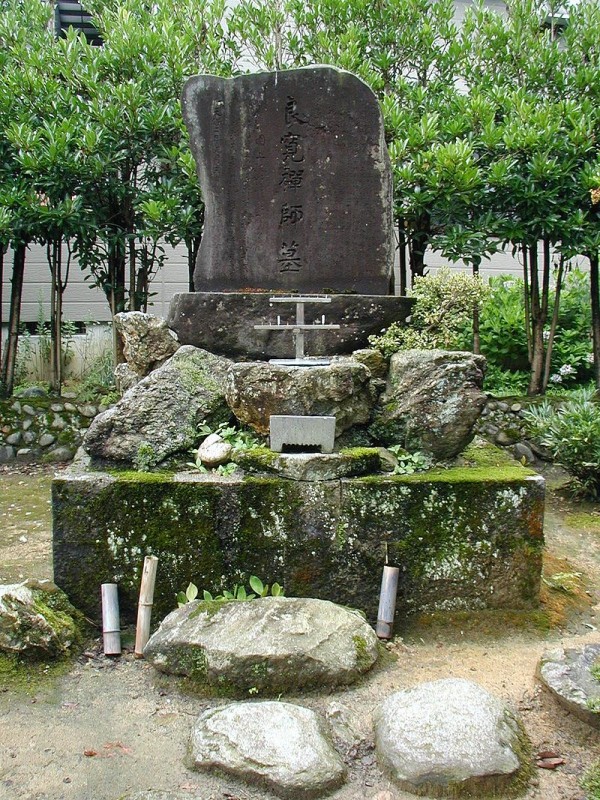 There are many individuals who exemplify the close ties between Zen and Shinto in Japanese history, particularly in the period before an artificial line was drawn between Buddhism and ‘the indigenous religion’ in Meiji times.
There are many individuals who exemplify the close ties between Zen and Shinto in Japanese history, particularly in the period before an artificial line was drawn between Buddhism and ‘the indigenous religion’ in Meiji times.
One such person is the poet Ryokan Taigu (1758-1831). His father was village headman, a job which would have included handling local (Shinto) rites. This was in a flourishing port called Izumozaki in Niigata, gateway for the Sado Island gold mines. Ryokan might have succeeded him but dropped out to become a Soto Zen monk. After obtaining his certificate of enlightenment, he wandered for five years before returning to live as a recluse in a hut on a hill near his hometown. Here he wrote poems, did calligraphy, and enjoyed games with the local children. He was a genial ‘big fool’ (Taigu), but a fool inspired by divine wisdom.
In 1826 at the age of 59, Ryokan felt physically incapable of continuing his life on Mt Kugami, and he moved into a Shinto shrine lower down the hill known as Otogo Jinja. He lived in a two-room hut next to the thatch-roofed Sanctuary. One can presume that in return for his lodging he looked after the shrine, sweeping the grounds and perhaps making offerings. A poem he wrote at the time reflects this:
When young, I learned literature but was too lazy to become a scholar.
Still young, I practiced Zen, but I never transmitted the dharma.
Now I live in a hermitage and guard a Shinto shrine.
I feel like half a shrine keeper and half a monk.
Reading through Ryokan with my poetry in translation study group, I can often sense a similarity with Shinto in the striving of the poet for Zen enlightenment. This is particularly evident in such matters as sincerity of purpose, identification with nature, and living in the present. It seems in many of his poems that he aspires to a state of complete selflessness, free of the ego which clouds human understanding.
kakubakari ukiyo to shiraba okuyama no kusanimo kinimo naramashi mono o
Had I known of this distressing world
I would like to have been
A blade of grass or a tree
On a remote mountain
Other of his poems are clearly inspired by Zen but have a strong Shinto element in their concern with natural purity versus the ‘pollution’ of human concerns. Zen like Shinto wishes ultimately to look into the soul-mirror and see no distorting ego (which is why both temples and shrines have mirrors on their altars).
Yamakage no iwama o tsutau kokemizu no kasukani ware wa sumiwataru kamo
Like the little stream
Making its way
Through the mossy crevices
I, too, quietly
Turn clear and transparent.
On his choice of life as a recluse, rather than living in a monkish community, he had this to say:
I don’t tell the murky world
to turn pure.
I purify myself and
check my reflection
in the water of the valley brook.
In old age Ryokan had time for reflection on having ‘idled his life away’, and his conclusion about what he will leave behind is so pure and selfless as to bring a smile to the face…
My legacy —
What will it be?
Flowers in spring,
The cuckoo in summer,
And the crimson maples
Of autumn.

Ryokan’s grave (courtesy Wikicommons)

Thank you for this post, John. I so miss our poetry group, but please allow me to add my favorite poem of Ryokan:
“Too lazy to be ambitious,
I let the world take care of itself.
Ten days’ worth of rice in my bag;
a bundle of twigs by the fireplace.
Why chatter about delusion and enlightenment?
Listening to the night rain on my roof,
I sit comfortably, with both legs stretched out.”
Ah, John, how wonderful to hear from you, and how our poetry group misses your input! A wonderful poem by Ryokan, very much in character, and not one which I think we’ve covered yet. So utterly beyond attachment! We’ll be looking at his Chinese poems next, then the final section with the young nun, Teishin. A bit more attachment there, I fancy…